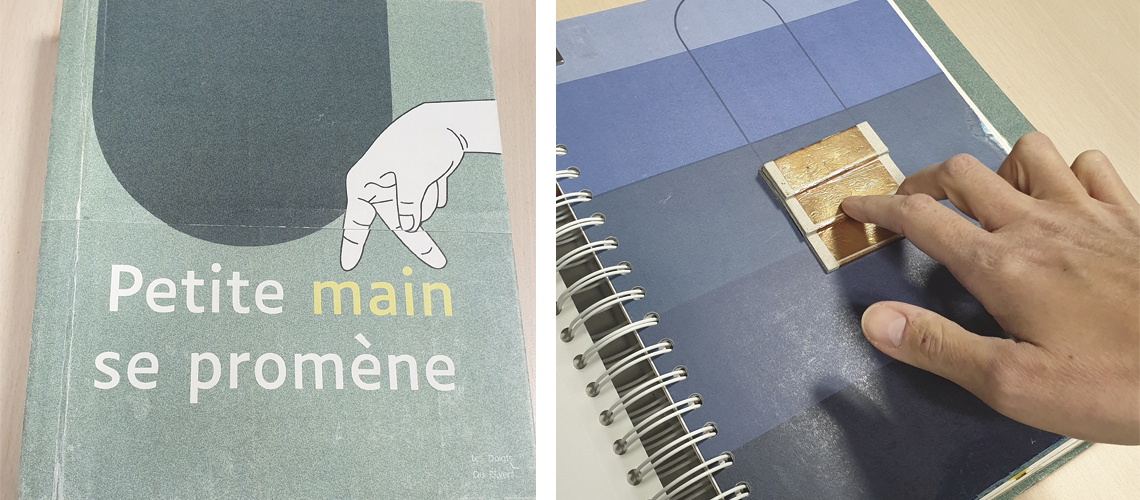A UNIGE team has worked in an innovative concept for a book for visually impaired children.

One of the 3D modules in the book: a miniature staircase to be climbed with the index and middle fingers. A footstep sound is made each time the fingers touch the module. © Dannyelle Valente / SMAS / Les Doigts qui rêvent
Children with visual impairment do not perceive the world in the same way as sighted people. As a result, they need specific educational tools, including children's books, that enhance their skills and senses. A team from the University of Geneva (UNIGE), in collaboration with the Université Lumière Lyon 2, the Université Paris 8 and the publishing house "Les Doigts Qui Rêvent", has designed a book of tactile illustrations to which sounds have been associated. This innovative tool makes it easier for children with or without visual impairment to identify objects. These results are published in the British Journal of Visual Impairment.
Children's books play a vital role in their development. They enable children to discover written and spoken language, as well as the world around them, through images. Books with tactile illustrations are particularly beneficial, but only if they are clearly understood by young readers. What about visually impaired or blind children, whose perception of the world differs from that of sighted people?
This category of children generally finds it difficult to identify the objects represented in traditional tactile books, usually in the form of simple drawings in relief. A house, for example, will be represented schematically by a triangle (the roof) and a square (the walls) in an embossed texture. As these two shapes refer to the visible features of the object, they will be difficult to interpret for children who have never been able to see a house.
Better suited to sensory experience
Specialised tactile books are available on the market. However, understanding the illustrations they contain often relies on prior visual experience. To solve this problem, a team from the University of Geneva (UNIGE) has created and tested a book of tactile illustrations whose interpretation does not rely on vision but on touch and hearing. This project was carried out in collaboration with Anna Rita Galiano, lecturer at the Université Lumière Lyon 2, and Dominique Archambault, professor at the CHArt laboratory (Human and Artificial Cognition) at the Université Paris 8. The latter has developed the technologies needed to detect readers' interactions with books. This study is part of the Tibontab (Tactile Illustrated Books on Tablet) project run by the publishing partner "Les Doigts Qui Rêvent".
"The idea was to offer an experience that better matched the sensory experience of children with visual impairment, so that they could identify objects they may never have seen before", explains Dannyelle Valente, research associate at Laboratory of Sensori-Motor, Affective and Social Development (SMAS) in the UNIGE Faculty of Psychology and Educational Sciences, lecturer in Research unit in Development, Individual, Processes, Handicap and Education, (DIPHE) at the Université Lumière Lyon 2, and first author of this study.
Combining gestures, shapes and sounds
In a previous study, the researchers designed and tested tactile illustrations in the form of small 3D modules (a miniature slide or swing). Visually impaired children had to explore these modules by touch, using two fingers - the index and middle fingers - as if they were their own legs. The researchers found that they were better able to visualise the objects in this way, rather than by touching simple drawings in relief based on their appearance. In the present study, these modules and associated manipulatives were brought together in a book and sounds were added.
Called "Petite main se promène" ("Little hand goes for a walk"), this book - still at the prototype stage - consists of four pages. Each page contains an action for children to perform with their hands, reminiscent of their real-life interactions with certain objects. On each page, children listen to sounds that encourage them to manipulate the objects. For example, when children hear the audio instruction "You too, climb the stairs with your fingers", they climb a small staircase that makes a footstep sound when it meets their fingers. The book was designed with the active participation of eleven children aged 5 to 11 with varying degrees of visual impairment.
More inclusive
"During the book reading tests, we observed the correspondence between the text and the exploration of the illustrations, as well as the children's expected achievements on each page. We compared the reading of a group of completely blind children with that of a group of children who still had some visual abilities. These tests revealed that the combination of gestures and sounds enabled these children, regardless of their visual abilities or visual experience, to recognise the objects depicted more easily and more quickly", explains Edouard Gentaz, full professor and director of the Laboratory of Sensori-Motor, Affective and Social Development (SMAS) in the UNIGE Faculty of Psychology and Educational Sciences.
These findings pave the way for the production of more inclusive and effective tactile books, regardless of children's visual experience. Following these promising results, the project team and the publishing house «Les Doigts Qui Rêvent» are working on a new prototype. In this new book, conductive fabrics and foams combined with electronic circuits are used to trigger new sounds and soundscapes in response to readers' gestures. This even more immersive book will soon be on the market.






